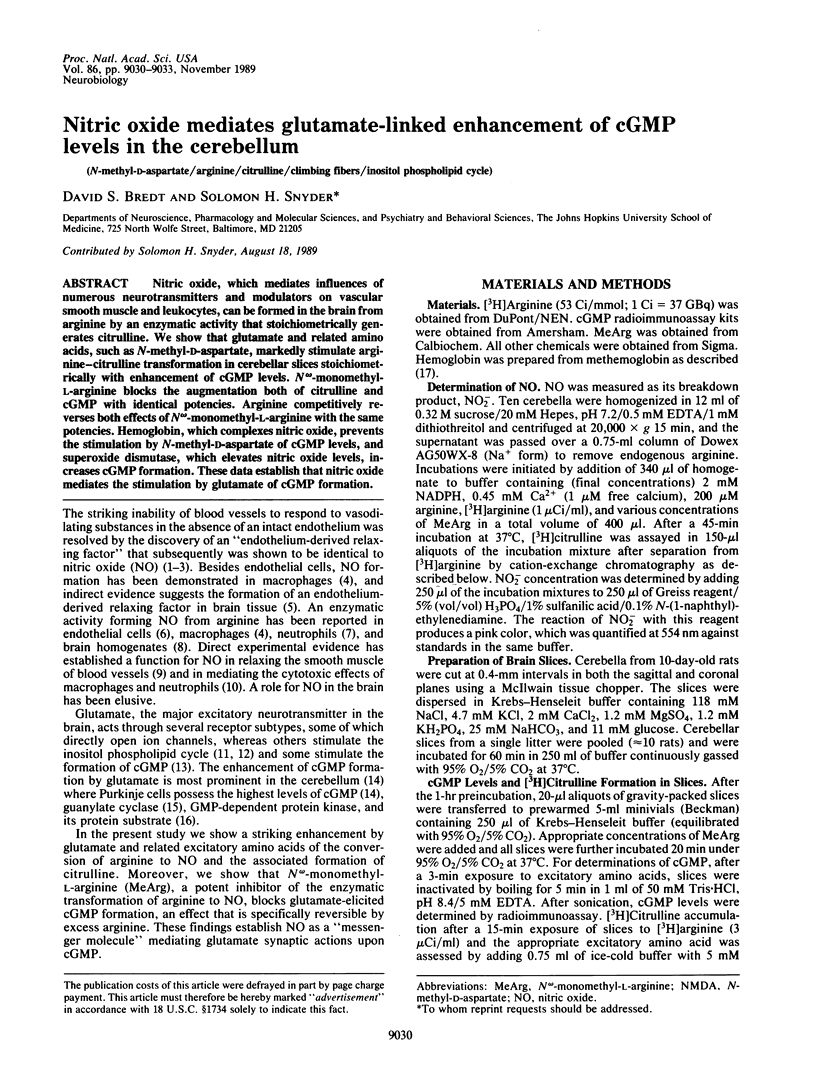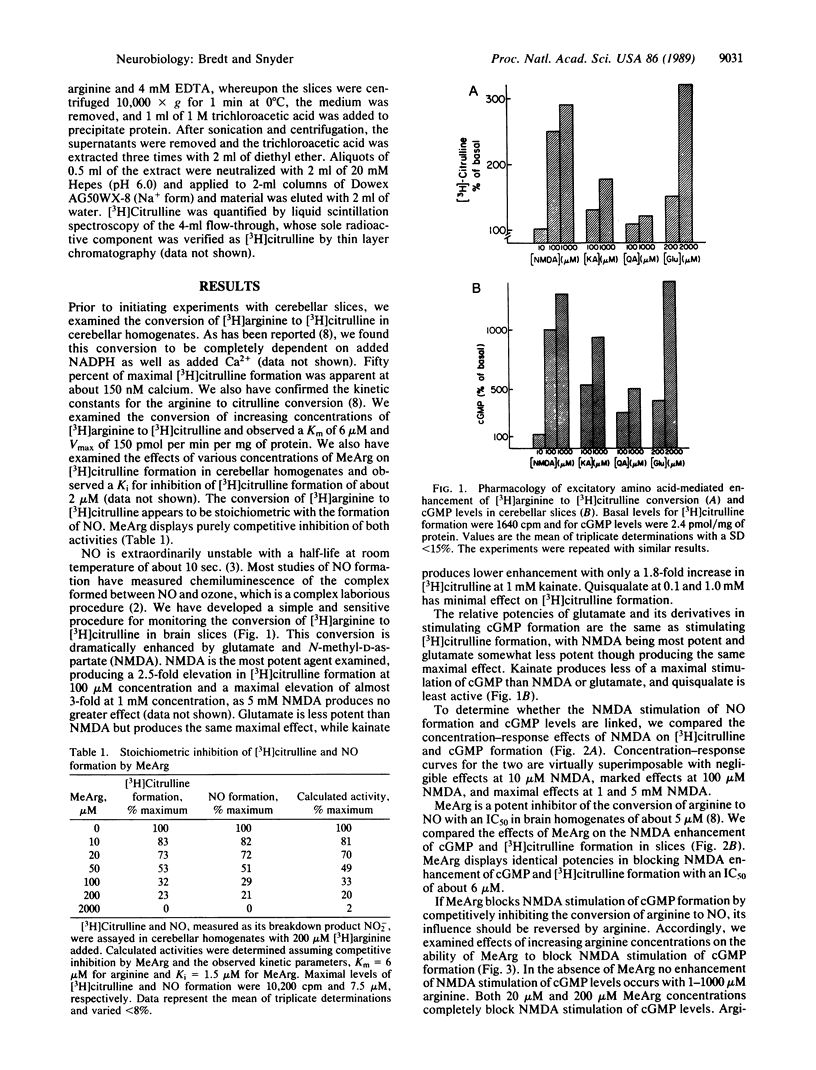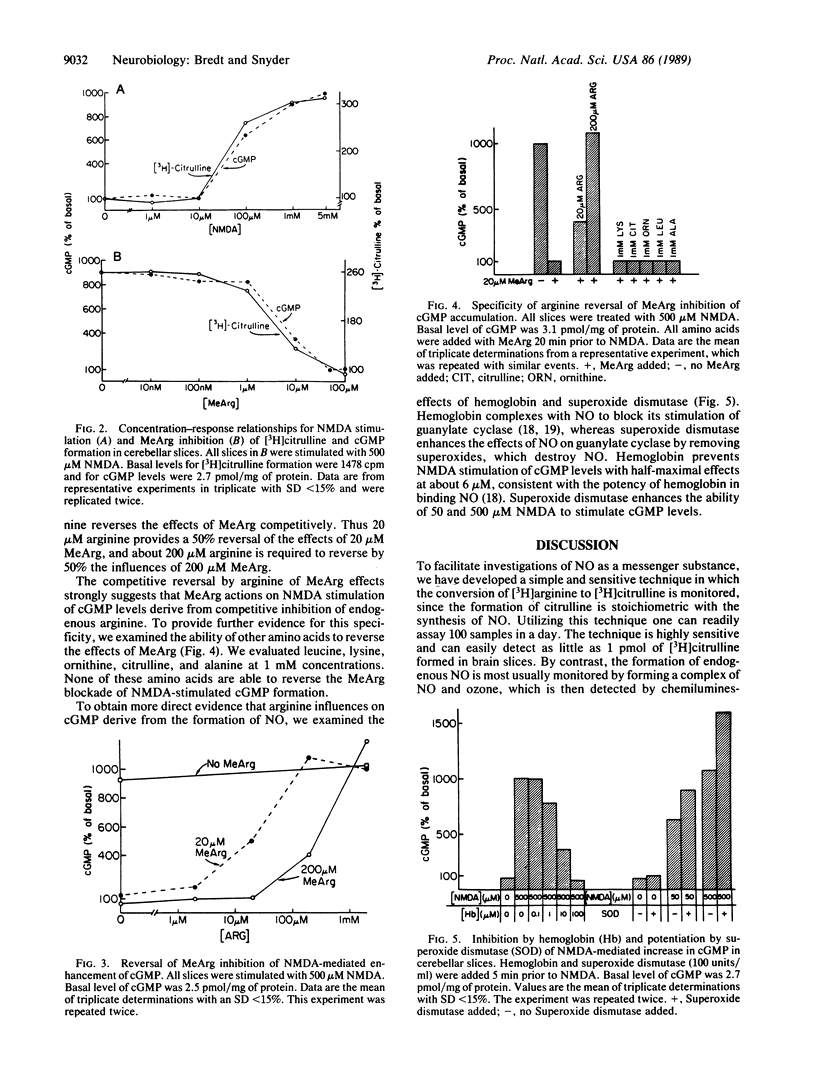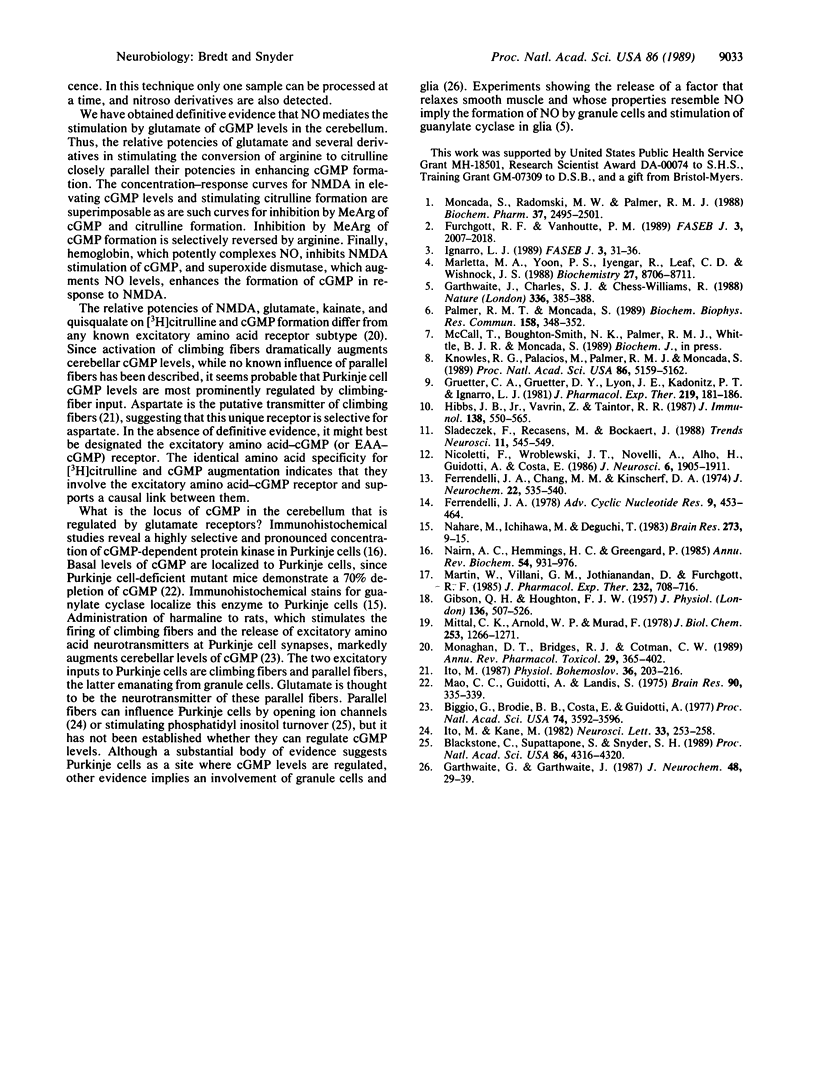Abstract
Nitric oxide, which mediates influences of numerous neurotransmitters and modulators on vascular smooth muscle and leukocytes, can be formed in the brain from arginine by an enzymatic activity that stoichiometrically generates citrulline. We show that glutamate and related amino acids, such as N-methyl-D-aspartate, markedly stimulate arginine--citrulline transformation in cerebellar slices stoichiometrically with enhancement of cGMP levels. N omega-monomethyl-L-arginine blocks the augmentation both of citrulline and cGMP with identical potencies. Arginine competitively reverses both effects of N omega-monomethyl-L-arginine with the same potencies. Hemoglobin, which complexes nitric oxide, prevents the stimulation by N-methyl-D-aspartate of cGMP levels, and superoxide dismutase, which elevates nitric oxide levels, increases cGMP formation. These data establish that nitric oxide mediates the stimulation by glutamate of cGMP formation.
Full text
PDF



Selected References
These references are in PubMed. This may not be the complete list of references from this article.
- Biggio G., Brodie B. B., Costa E., Guidotti A. Mechanisms by which diazepam, muscimol, and other drugs change the content of cGMP in cerebellar cortex. Proc Natl Acad Sci U S A. 1977 Aug;74(8):3592–3596. doi: 10.1073/pnas.74.8.3592. [DOI] [PMC free article] [PubMed] [Google Scholar]
- Blackstone C. D., Supattapone S., Snyder S. H. Inositolphospholipid-linked glutamate receptors mediate cerebellar parallel-fiber-Purkinje-cell synaptic transmission. Proc Natl Acad Sci U S A. 1989 Jun;86(11):4316–4320. doi: 10.1073/pnas.86.11.4316. [DOI] [PMC free article] [PubMed] [Google Scholar]
- Ferrendelli J. A., Chang M. M., Kinscherf D. A. Elevation of cyclic GMP levels in central nervous system by excitatory and inhibitory amino acids. J Neurochem. 1974 Apr;22(4):535–540. doi: 10.1111/j.1471-4159.1974.tb06890.x. [DOI] [PubMed] [Google Scholar]
- Ferrendelli J. A. Distribution and regulation of cyclic GMP in the central nervous system. Adv Cyclic Nucleotide Res. 1978;9:453–464. [PubMed] [Google Scholar]
- Furchgott R. F., Vanhoutte P. M. Endothelium-derived relaxing and contracting factors. FASEB J. 1989 Jul;3(9):2007–2018. [PubMed] [Google Scholar]
- GIBSON Q. H., ROUGHTON F. J. The kinetics and equilibria of the reactions of nitric oxide with sheep haemoglobin. J Physiol. 1957 May 23;136(3):507–524. doi: 10.1113/jphysiol.1957.sp005777. [DOI] [PMC free article] [PubMed] [Google Scholar]
- Garthwaite J., Charles S. L., Chess-Williams R. Endothelium-derived relaxing factor release on activation of NMDA receptors suggests role as intercellular messenger in the brain. Nature. 1988 Nov 24;336(6197):385–388. doi: 10.1038/336385a0. [DOI] [PubMed] [Google Scholar]
- Garthwaite J., Garthwaite G. Cellular origins of cyclic GMP responses to excitatory amino acid receptor agonists in rat cerebellum in vitro. J Neurochem. 1987 Jan;48(1):29–39. doi: 10.1111/j.1471-4159.1987.tb13123.x. [DOI] [PubMed] [Google Scholar]
- Gruetter C. A., Gruetter D. Y., Lyon J. E., Kadowitz P. J., Ignarro L. J. Relationship between cyclic guanosine 3':5'-monophosphate formation and relaxation of coronary arterial smooth muscle by glyceryl trinitrate, nitroprusside, nitrite and nitric oxide: effects of methylene blue and methemoglobin. J Pharmacol Exp Ther. 1981 Oct;219(1):181–186. [PubMed] [Google Scholar]
- Hibbs J. B., Jr, Vavrin Z., Taintor R. R. L-arginine is required for expression of the activated macrophage effector mechanism causing selective metabolic inhibition in target cells. J Immunol. 1987 Jan 15;138(2):550–565. [PubMed] [Google Scholar]
- Ignarro L. J. Endothelium-derived nitric oxide: actions and properties. FASEB J. 1989 Jan;3(1):31–36. doi: 10.1096/fasebj.3.1.2642868. [DOI] [PubMed] [Google Scholar]
- Ito M., Kano M. Long-lasting depression of parallel fiber-Purkinje cell transmission induced by conjunctive stimulation of parallel fibers and climbing fibers in the cerebellar cortex. Neurosci Lett. 1982 Dec 13;33(3):253–258. doi: 10.1016/0304-3940(82)90380-9. [DOI] [PubMed] [Google Scholar]
- Ito M. Signal processing in cerebellar Purkinje cells. Physiol Bohemoslov. 1987;36(3):203–216. [PubMed] [Google Scholar]
- Knowles R. G., Palacios M., Palmer R. M., Moncada S. Formation of nitric oxide from L-arginine in the central nervous system: a transduction mechanism for stimulation of the soluble guanylate cyclase. Proc Natl Acad Sci U S A. 1989 Jul;86(13):5159–5162. doi: 10.1073/pnas.86.13.5159. [DOI] [PMC free article] [PubMed] [Google Scholar]
- Mao C. C., Guidotti A., Landis S. Cyclic GMP: reduction of cerebellar concentrations in "nervous" mutant mice. Brain Res. 1975 Jun 13;90(2):335–339. doi: 10.1016/0006-8993(75)90316-9. [DOI] [PubMed] [Google Scholar]
- Marletta M. A., Yoon P. S., Iyengar R., Leaf C. D., Wishnok J. S. Macrophage oxidation of L-arginine to nitrite and nitrate: nitric oxide is an intermediate. Biochemistry. 1988 Nov 29;27(24):8706–8711. doi: 10.1021/bi00424a003. [DOI] [PubMed] [Google Scholar]
- Martin W., Villani G. M., Jothianandan D., Furchgott R. F. Selective blockade of endothelium-dependent and glyceryl trinitrate-induced relaxation by hemoglobin and by methylene blue in the rabbit aorta. J Pharmacol Exp Ther. 1985 Mar;232(3):708–716. [PubMed] [Google Scholar]
- Mittal C. K., Arnold W. P., Murad F. Characterization of protein inhibitors of guanylate cyclase activation from rat heart and bovine lung. J Biol Chem. 1978 Feb 25;253(4):1266–1271. [PubMed] [Google Scholar]
- Monaghan D. T., Bridges R. J., Cotman C. W. The excitatory amino acid receptors: their classes, pharmacology, and distinct properties in the function of the central nervous system. Annu Rev Pharmacol Toxicol. 1989;29:365–402. doi: 10.1146/annurev.pa.29.040189.002053. [DOI] [PubMed] [Google Scholar]
- Moncada S., Radomski M. W., Palmer R. M. Endothelium-derived relaxing factor. Identification as nitric oxide and role in the control of vascular tone and platelet function. Biochem Pharmacol. 1988 Jul 1;37(13):2495–2501. doi: 10.1016/0006-2952(88)90236-5. [DOI] [PubMed] [Google Scholar]
- Nairn A. C., Hemmings H. C., Jr, Greengard P. Protein kinases in the brain. Annu Rev Biochem. 1985;54:931–976. doi: 10.1146/annurev.bi.54.070185.004435. [DOI] [PubMed] [Google Scholar]
- Nakane M., Ichikawa M., Deguchi T. Light and electron microscopic demonstration of guanylate cyclase in rat brain. Brain Res. 1983 Aug 22;273(1):9–15. doi: 10.1016/0006-8993(83)91088-0. [DOI] [PubMed] [Google Scholar]
- Nicoletti F., Wroblewski J. T., Novelli A., Alho H., Guidotti A., Costa E. The activation of inositol phospholipid metabolism as a signal-transducing system for excitatory amino acids in primary cultures of cerebellar granule cells. J Neurosci. 1986 Jul;6(7):1905–1911. doi: 10.1523/JNEUROSCI.06-07-01905.1986. [DOI] [PMC free article] [PubMed] [Google Scholar]
- Palmer R. M., Moncada S. A novel citrulline-forming enzyme implicated in the formation of nitric oxide by vascular endothelial cells. Biochem Biophys Res Commun. 1989 Jan 16;158(1):348–352. doi: 10.1016/s0006-291x(89)80219-0. [DOI] [PubMed] [Google Scholar]
- Sladeczek F., Récasens M., Bockaert J. A new mechanism for glutamate receptor action: phosphoinositide hydrolysis. Trends Neurosci. 1988 Dec;11(12):545–549. doi: 10.1016/0166-2236(88)90183-x. [DOI] [PubMed] [Google Scholar]


